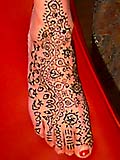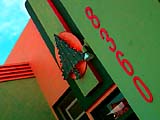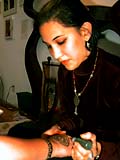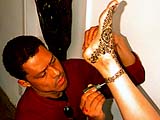The Mehndi Project
By Clare Guerrero
 You may have already seen No Doubt's Gwen Stefani wearing beautiful
lace-like tattoos in her video or perhaps Naomi Campbell's detailed shoulder
in a recent Harper's Bazaar layout. Well, these beautiful designs are called
Mehndi, and it hit the popular scene just last summer with an opening at
a New York City gallery. Now there's a new exhibit on the West Coast featuring
this unique body art.
You may have already seen No Doubt's Gwen Stefani wearing beautiful
lace-like tattoos in her video or perhaps Naomi Campbell's detailed shoulder
in a recent Harper's Bazaar layout. Well, these beautiful designs are called
Mehndi, and it hit the popular scene just last summer with an opening at
a New York City gallery. Now there's a new exhibit on the West Coast featuring
this unique body art.
Mehndi artist Loretta Roome decided that Los Angeles, famous for its exhibitionist tendencies, would be a perfect place to introduce the ancient Indian art of henna body painting that's fast becoming a painless alternative to tattooing.
The gallery is a small, rectangular-shaped space with warm light coming through the sheer, white curtains and soothing Indian music playing in the background. The artists have set up a sort of salon area in the corner with an L-shaped banquette lined with pillows, where the client lays while the Mehndi is being applied. There's a low, round table filled with bowls and small bottles of the henna paste and a lemon juice solution that is applied after the design is completed.
At Galerie LaKaye you can propose your own design or, for something more authentic, you can look through a selection of Indian prints. Unlike traditional Mehndi, which is done only as decoration on hands and feet, nowadays people are having it done wherever it strikes their fancy. On a recent visit to the gallery, one woman was laying patiently as a Mehndi artist was decorating her navel, while another woman was having her foot done. Gallery owner Carine Fabius, obviously a fan of her new exhibit, came over to take a look at the work and exclaimed, "Oh my god, it's so beautiful who's ever gonna want to wear shoes again?" That probably means the other big trend this summer will be strappy sandals.
Although some of the value of the significance of Mehndi is bound to be lost in this gobble-them-up, spit-them-out trendy culture, the beauty of the designs is enough to speak for itself. "We've already had a great response," says Fabius, just two days after its opening. "We had about 400 people here for opening night and about fifty people a day since then." The great response has prompted the gallery to say that while the exhibition of Mehndi art work -- which includes a collection of beautiful photographs -- will terminate mid-February, the "Mehndi Project" will go on indefinitely.
Frequently Asked Questions (Courtesy of Galerie Lakaye) How long does it last? What color will it be after the mud comes off? Galerie LaKaye is located at 8360 W. 3rd Street in Los Angeles. Their phone number is (213) 653-1724.
|
 Roome and seven other Mehndi artists, including her teacher, Rani Patel,
got together to form the "Mehndi Project," which debuted January
16th at Galerie LaKaye in Beverly Hills.
Roome and seven other Mehndi artists, including her teacher, Rani Patel,
got together to form the "Mehndi Project," which debuted January
16th at Galerie LaKaye in Beverly Hills.  The henna paste is a completely herbal compound, so there are essentially
no known health risks involved. And, depending on how long you leave the
paste on, it will dye the skin a reddish-brown that will last up to one
month. Prices range from $20.00 for a small design and go up from there.
The henna paste is a completely herbal compound, so there are essentially
no known health risks involved. And, depending on how long you leave the
paste on, it will dye the skin a reddish-brown that will last up to one
month. Prices range from $20.00 for a small design and go up from there.
 Mehndi has many traditional meanings, depending on the North African or
Indian culture. "August is a holy month in India and we fast,"
a soft-spoken Patel tells me. "The women and girls do Mehndi painting
on each other and it is a form of meditation for the one applying it. The
designs can take hours to complete."
Mehndi has many traditional meanings, depending on the North African or
Indian culture. "August is a holy month in India and we fast,"
a soft-spoken Patel tells me. "The women and girls do Mehndi painting
on each other and it is a form of meditation for the one applying it. The
designs can take hours to complete."